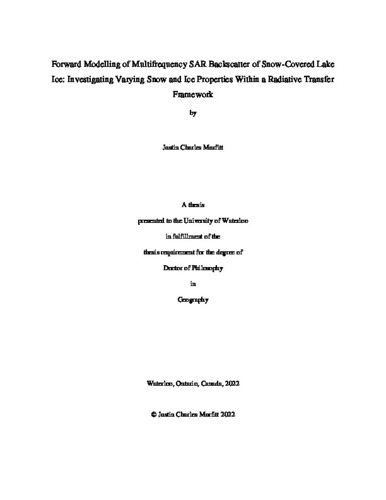| dc.description.abstract | Lakes are a key feature in the Northern Hemisphere landscape. The coverage of lakes by ice cover has important implications for local weather conditions and can influence energy balance. The presence of lake ice is also crucial for local economies, providing transportation routes, and acting as a source of recreation/tourism and local customs. Both lake ice cover, from which ice dates and duration can be derived (i.e., ice phenology), and ice thickness are considered as thematic variables of lakes as an essential climate variable by the Global Climate Observing System (GCOS) for understanding how climate is changing. However, the number of lake ice phenology ground observations has declined over the past three decades. Remote sensing provides a method of addressing this paucity in observations. Active microwave remote sensing, in particular synthetic aperture radar (SAR), is popular for monitoring ice cover as it does not rely on sunlight and the resolution allows for the monitoring of small and medium-sized lakes. In recent years, our understanding of the interaction between active microwave signals and lake ice has changed, shifting from a double bounce mechanism to single bounce at the ice-water interface. The single bounce, or surface scattering, at the ice-water interface is due to a rough surface and high dielectric contrast between ice and water. However, further work is needed to fully understand how changes in different lake ice properties impact active microwave signals. Radiative transfer modelling has been used to explore these interactions, but there are a variety of limitations associated with past experiments. This thesis aimed to faithfully represent lake ice using a radiative transfer framework and investigate how changes in lake ice properties impact active microwave backscatter. This knowledge was used to model backscatter throughout ice seasons under both dry and wet conditions. The radiative transfer framework used in this thesis was the Snow Microwave Radiative Transfer (SMRT) model.
To investigate how broad changes in ice properties impact microwave backscatter, SMRT was used to conduct experiments on ice columns representing a shallow lake with tubular bubbles and a deep lake without tubular bubbles at L/C/X-band frequencies. The Canadian Lake Ice Model (CLIMo) was used to parameterize SMRT. Ice properties investigated included ice thickness, snow ice bubble radius and porosity, root mean square (RMS) height of the ice-water interface, correlation length of the ice-water interface, and tubular bubble radius and porosity. Modelled backscatter indicated that changes in ice thickness, snow ice porosity, and tubular bubble radius and porosity had little impact on microwave backscatter. The property that had the largest impact on backscatter was RMS height at the ice-water interface, confirming the results of other recent studies. L and C-band frequencies were found to be most sensitive to changes in RMS height. Bubble radius had a smaller impact on backscatter, but X-band was found to be most sensitive to changes in this property and would be a valuable frequency for studying surface ice conditions.
From the results of these initial experiments, SMRT was then used to simulate the backscatter from lake ice for two lakes during different winter seasons. Malcolm Ramsay Lake near Churchill, Manitoba, represented a shallow lake with dense tubular bubbles and Noell lake near Inuvik, Northwest Territories, represented a deep lake with no tubular bubbles. Both field data and CLIMo simulations for the two lakes were used to parameterize SMRT. Because RMS height was determined to be the ice property that had the largest impact on backscatter, simulations focused on optimizing this value for both lakes. Modelled backscatter was validated using C-band satellite imagery for Noell Lake and L/C/X-band imagery for Malcolm Ramsay Lake. The root mean square error values for both lakes ranged from 0.38 to 2.33 dB and Spearman’s correlation coefficient (ρ) values >0.86. Modelled backscatter for Noell Lake was closer to observed values compared to Malcolm Ramsay Lake. Optimized values of RMS height provided a better fit compared to a stationary value and indicated that roughness likely increases rapidly at the start of the ice season but plateaus as ice growth slows.
SMRT was found to model backscatter from ice cover well under dry conditions, however, modelling backscatter under wet conditions is equally important. Detailed field observations for Lake Oulujärvi in Finland were used to parameterize SMRT during three different conditions. The first was lake ice with a dry snow cover, the second with an overlying layer of wet snow, and the third was when a slush layer was present on the ice surface. Experiments conducted under dry conditions continued to support the dominance of scattering from the ice-water interface. However, when a layer of wet snow or slush layer was introduced the dominant scattering interface shifted to the new wet layer. Increased roughness at the boundary of these wet layers resulted in an increase in backscatter. The increase in backscatter is attributed to the higher dielectric constant value of these layers. The modelled backscatter was found to be representative of observed backscatter from Sentinel-1.
The body of work of this thesis indicated that the SMRT framework can be used to faithfully represent lake ice and model backscatter from ice covers and improved understanding of the interaction between microwave backscatter and ice properties. With this improved understanding inversion models can be developed to retrieve roughness of the ice-water interface, this could be used to build other models to estimate ice thickness based on other remote sensing data. Additionally, insights into the impact of wet conditions on radar backscatter could prove useful in identifying unsafe ice locations. | en |

